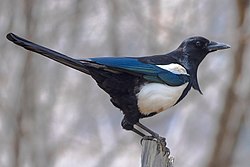| Black-rumped magpie | |
|---|---|
 | |
| From Bumthang, Bhutan | |
| Scientific classification | |
| Domain: | Eukaryota |
| Kingdom: | Animalia |
| Phylum: | Chordata |
| Class: | Aves |
| Order: | Passeriformes |
| Family: | Corvidae |
| Genus: | Pica |
| Species: | P. bottanensis |
| Binomial name | |
| Pica bottanensis Delessert, 1840 | |
The black-rumped magpie (Pica bottanensis) is a species of magpie found in central Bhutan to west-central China. [1] It was formerly classified as a subspecies of the Eurasian magpie (Pica pica).
A molecular phylogenetic study published in 2018 found that the black-rumped magpie is a sister taxon to the Asir magpie from southwestern Saudi Arabia. [2]